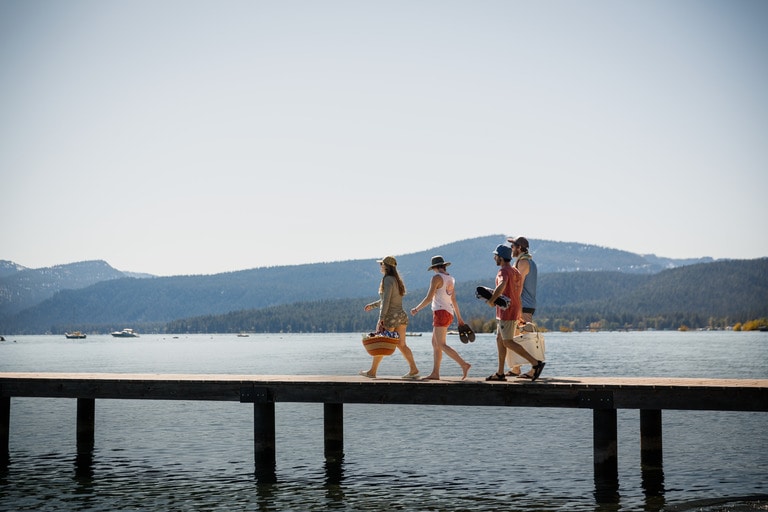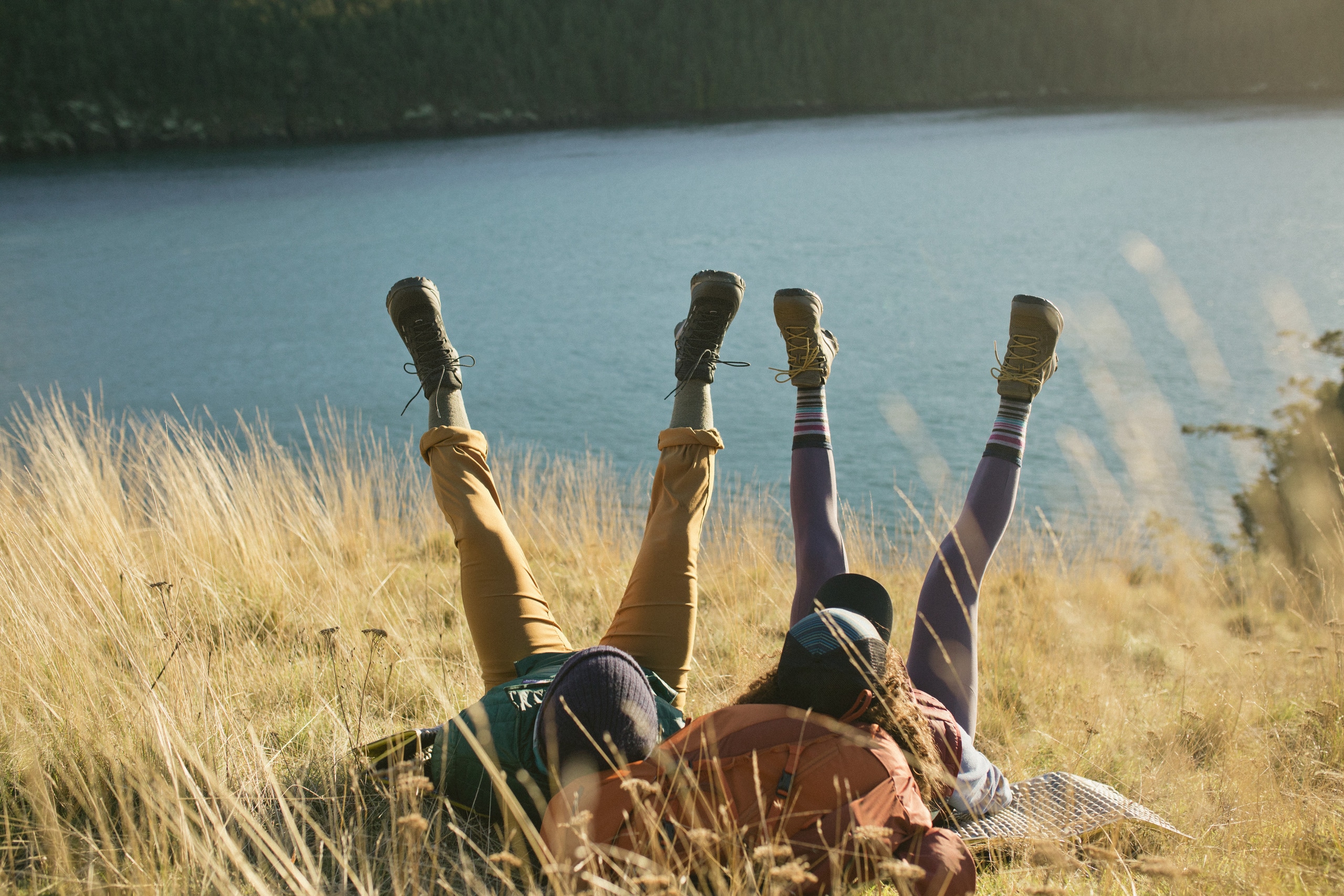When headed out to a dreamy vacation you've been planning for months, it can be tempting to ditch your fitness goals along with the intensity of work and daily demands. Who wants to work out when your plans mostly involve lounging by the campfire or relaxing by the pool, reading a novel or two and drinking something delicious?
But if you've spent weeks or months training for a marathon or an active goal like a multiday backpack and you're wondering how the heck you're going to keep it up while you're away from homebase, never fear: There are simple effective ways to maintain your fitness routine.
Here is a step-by-step plan to help you maintain your fitness while on vacation and ways to check in with your body when you return from your time away.
Know the benefits of staying fit. Staying on top of your training while you're away—even if you lighten the load—can help you meet your goals and avoid losing muscle mass, skill, or endurance capacity.
Assess the style of vacation you're taking. There may already be built-in opportunities to keep moving on your trip, especially if you're planning to walk around a new city, hike to and from a campsite or engage with another type of activity like kayaking or climbing.
Set achievable fitness goals. Start by making sure you know what you want to achieve, so you can decide what type and how much movement you'll want to plan on building in to your itinerary.
Create a plan to move while you're away. Do some research about what's available where you're staying and what kind of activities you'd like to use to maintain fitness. Your marathon-training long run may be able to wait until you're home if you keep up with tempo runs, or you can stay saddle-ready for a century ride by renting cruiser bikes for sightseeing, for example.
Make movement a habit. Setting timers for yourself, recruiting your fellow travelers and making sure you have workouts downloaded beforehand can help you prioritize your fitness.
Ease back into your fitness plan at home. Longer vacations may come with increased changes to your diet and sleep habits along with the stress and exhaustion of travel. You may need to adjust your activity level in order to avoid burnout or injury.
Keep gear on the light side. You don't need to pack bulky gear or tote equipment around in order to maintain your fitness—but if you do want to bring some tools, consider portable pieces like travel yoga mats, resistance bands and recovery aids.
All of these tips and tricks are not only designed to help you keep up with your goals while you're on vacation: They can also be helpful to incorporate into your regular training, off-season maintenance and recovery routines. Our experts offer four basic movements—a plank, push-up, squat, and row—that can help you get the job done no matter where you are, no equipment necessary.
The Benefits of Staying Fit
Even if you're not training for a a major objective or endurance challenge, it's worthwhile to consider reframing your vacation to include fitness and movement of some type. Movement is proven to boost mental health and happiness, not to mention it provides you with long-term health benefits such as building and maintaining muscle mass, stability and endurance.
"With long flights or lots of sitting or stress changes in an environment, a movement practice can go a long way to relax and settle in and offset those stressors," says Elena Cheung, a yoga and movement specialist and host of the REI series, Deeply Moving. Movement also "can be a way of maintaining consistency so you don't lose it when you get back," she says.
If you are taking a vacation packed with movement like camping and hiking, going on a kayak trip or climbing, your trip may be an opportunity to remember your life is active and full, so enjoy the chance to take it down a notch. Even if your trip doesn't appear to be an active one, it's still easy to add movement and fitness-maintaining activity to the days.
It's also worth noting that it takes two to three weeks of inactivity to see changes in muscle mass or strength, so you may not experience much change at all, says physical therapist Sam Van Gorder.
Above all, as you map out your time away along with your fitness goals, be gentle with yourself. Now is not the time to clock your fastest run time; remember the point of vacation—taking time away from daily pressure and stress.
Assess the Style of Vacation You're Taking
Before you come up with your fitness plan, it helps to assess how much you're already going to be moving on vacation and the type of movement you'll be doing.
We tend to think of fitness or movement as limited to fitness classes, epic bike rides or an intense multi-pitch climb. But movement is more complex than that, Cheung says, and includes many activities, like walking or playing with kids.
Headed to an amusement park, visiting a foreign city or planning to hike with the family? That is a lot of walking. Going on a kayaking trip? That's an upper-body workout. Spending the day exploring mountains with your kids? That's a full day of movement.
"People forget you can get some serious steps in," says Cheung of certain types of vacations.
If your vacation already includes some substantial walking, hiking or other types of movement, you might not have the energy to also add in a full round of weightlifting or an extra run, so take that into consideration. Or save your long run or strength training for a more relaxing day, rather than one packed with activity.
If you're planning a relaxing trip and your only steps will be to and from the pool, consider planning workouts in advance to make sure you get some movement in. If you know in advance that you might want to have some evening beach walks—a great choice for strong legs and core—you'll be more likely to follow through.
Most importantly, your vacation is not the time to be a perfectionist about your workouts and ensuring you hit every single workout.
"Whatever you choose, make it consciously, and it's OK," Cheung says. "Commit to it."

Set Achievable Fitness Goals
Whether you're an athlete, in training for an activity or simply interested in moving your body and staying healthy on a getaway, the first step is to get clarity before you go on your vacation. Look at your specific fitness goals and consider how much training you want—or need—to incorporate into your trip.
If your goal is simple, like moving more consistently on the vacation or maintaining a baseline of fitness rather than being purely sedentary, setting clear and intentional goals can help you achieve that, Cheung says.
Deloading, or having a recovery week where you scale down the intensity of your training, is an important part of an athlete's training cycle, she says. All athletes need time and space to recover during training; you can't go hard all the time. But if you have a more specific goal, like running a marathon or completing a century ride, it's still helpful to clarify what you're trying to achieve while you're in a new place and research what it might require to stay on track. (For more tips, read How to Run on Vacation).
Like anything, it's about finding a balance. Vacation is still a good time to work on joint mobility and stability and to make sure you're still doing something to stretch and actively recover.
Create a Plan to Move While You're Away
Figuring out how much you'll need to move or how active you'll need to be will depend on your goals as well as the type of activity you're doing. If you're training for a marathon, consider timing your next long run for when you are back home. If you're planning on riding a century this fall, look for a way to hop on a bike once or twice during your time off, or use the week to do some core strength training instead.
For a week-long vacation, Van Gorder recommends building in two strength days and two light cardio days. "It's a maintenance phase, not going out and PR-ing [hitting a personal record, or PR] on your 8K." If you're working with a trainer, ask them for more specific recommendations based on your plans and progress. Or consult your training program to see what types of workouts are necessary to build or maintain a base, and which offer a little more wiggle room.
Do research to find fitness resources. Once you know how often you realistically will work out, or even need to work out, do some research. See if the hotel has a gym (or better yet, book a hotel with a gym if that's important to you) or if a local running store hosts casual group runs. Check the neighborhood where you are staying for gyms or studios with classes that let you drop in. Commit to some class times and put them in your calendar.
Have videos or workout plans available offline. If you are doing your own workouts in your hotel or Airbnb, download some videos in advance so you don't have to hunt around for them once you're there. (Cheung's Deeply Moving series is a great place to start.)
Get creative with what "counts" as fitness activity. There are easy ways to stretch and move throughout the day, which can help with joint health and overall mobility. Do some squats while you're waiting in line (see 4 Simple Moves to Do Anywhere below), or stretch your chest open on a doorway, Van Gorder suggests. Take a walk after dinner or, better yet, walk to the restaurant. Explore your new destination by bike or foot. If you've planned a pool or beach day, commit to swimming laps for a set time. Getting together with friends while traveling? Ask them to take you on a run, hike or to rent bikes together for a day of exploring.
Be flexible (or go easy on yourself). You also might find that after a big walking day, you don't have energy for a planned strength or cardio workout. Remember to be flexible about the plan you've created and take into account your own fatigue and energy levels. Not to mention this important fact: You're on vacation!
Make Movement a Habit
One big barrier that can come up while on vacation is actually following your fitness plan. Your hotel gym might not have the equipment you're used to, or you are camping and don't want to roll out a yoga mat on the ground (see How to Take Your Workout Outdoors). You also don't have all the usual environmental signals, like the end of a workday or a set class time that declare to your brain, "Time to work out!"
Set reminders. In an unfamiliar setting, it makes a difference to set up reminders that it's time to move. Place your yoga mat and resistance bands somewhere visible. Put a reminder on your phone. Bring sticky notes and post them to remind yourself of your commitment.
Be active with others. If your travel partners are also interested in staying fit during vacation, have them be your accountability buddies, especially if you are on a family vacation and you know you'll be tied up with lots of events.
"Find an accountability buddy to go to nearest yoga studio," Cheung suggests. "Take a walk with family after dinner."
Ease Back Into Your Fitness Plan at Home
Perhaps you went on vacation with a full fitness plan—but then skipped all the strength days (and the cardio too). Not only that, travel fatigue and eating rich restaurant meals have made you feel sluggish.
First, that's completely normal. Van Gorder says don't beat yourself up. Remember, it takes two to three weeks of inactivity to see a decrease in muscle mass or strength, so you may not experience much impact at all, she says. Your sleep and eating patterns likely changed while you were away and travel itself can be stressful. So, ease yourself back in, she says.
When returning to your regular fitness routine, check in on how you are moving. How does my squat feel? Is my push-up or row still the same? If not, take the intensity down. Go gentler for the workout and see how your body feels. If it's as sore as you are expecting, get back into the routine from where you are rather than where you were, Van Gorder says.
Keep Gear on the Light Side
When traveling, you likely won't have a ton of room for extra fitness gear. Fortunately, you don't need to carry 20-pound dumbbells to work out while you're out on the road.
Here are some portable, packable options that might be a good fit.
Yoga mat Any yoga mat will do, but a light travel version can be folded up in your suitcase. You can roll it out on the floor for yoga or stretching, or use it to have a grippy surface while doing a bodyweight or High Intensity Interval Training (HIIT) workout in a hotel room. It's a great place to do a few lunges, squats or planks, or to unwind after you get off the plane.
Resistance bands These light, stretchy bands offer a way to do strength work while on the road—plus, they are easy to tuck into your bag. (See Resistance Bands Workouts for Any Body).
A massage or lacrosse ball These balls provide targeted pressure to muscles and provide relief and release knots and built-up tension. Use the massage ball to roll out feet tired out from all the walking you're doing on vacation. If your shoulders feel tight from a backpack, lay over the ball on the ground to release your upper back.
4 Simple Moves to Do Anywhere
If you're not in training for a particular sport or goal and simply want to make sure you are doing some movement on vacation, here are four simple moves you can do anywhere. These are all easy to modify and don't require much (or any) equipment, Van Gorder says.
Squat You squat to sit in a chair, so you could do a few extra every time you sit down. Or do 5 to 10 squats a couple of times per day.
Push-up Putting your bag into the overhead bin requires push-up strength. Or get down on the ground and give us 10!
Plank You can do plank holds at any time while the rest of your family relaxes: Get on the ground with legs straight or knees down to modify, stacking hands under your shoulders, or do a hold against a wall while waiting in line.
Row When you get the luggage at baggage claim, you can use your rowing muscles. Another option: sit with your legs extended, wrap a resistance band around your feet and grab the band to do a few extra reps. Or rent a canoe for some extra rowing strength combined with adventure!



